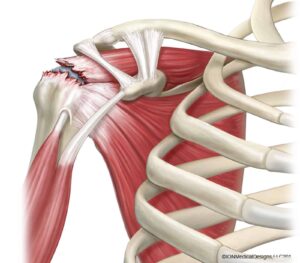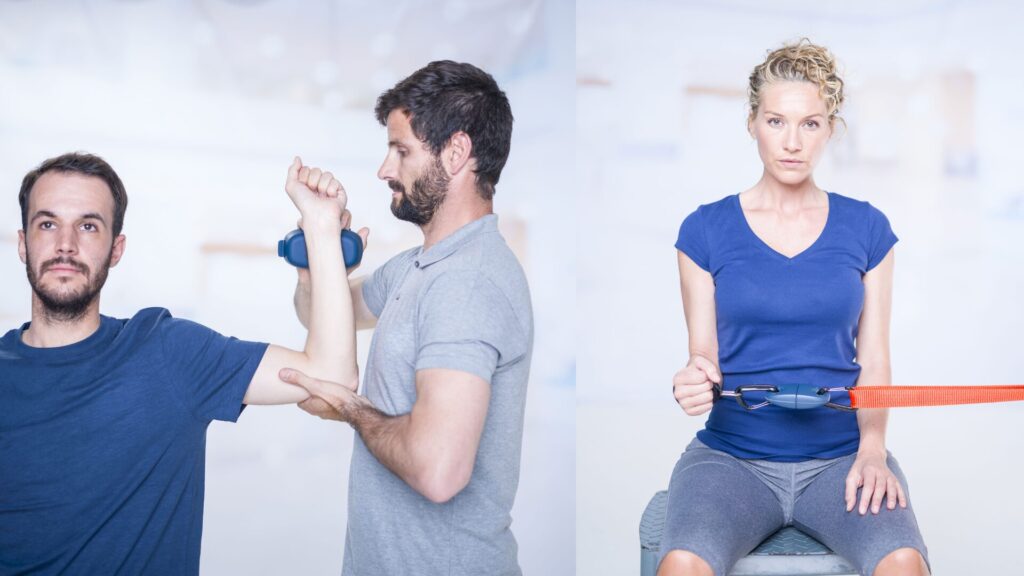Shoulder rotator assessment is crucial for understanding the balance between internal and external rotator muscles, a key factor in injury prevention and performance optimization, particularly in overhead sports (for example: handball, volleyball, baseball, etc.). The ER/IR ratio helps identify potential muscle imbalances. With modern tools like the handheld dynamometers, this analysis is now simple, accurate, and easily applicable in the clinic.
In this article, we break down what rotator cuff ratios actually mean, how to test them in practice, and, most importantly, how to prevent and correct any imbalances.
Whether you’re a physical therapist, strength coach, or athlete seeking to protect your shoulders, this guide will help you better understand, measure, and address muscle imbalances related to the rotator cuff.
CONTENTS:
1- Why Assess Shoulder Rotators?
2- Understanding the ER/IR Ratios: Definitions & Norms
3- Detecting Imbalances: Asymmetries and Critical Thresholds
4- Shoulder Rotator Assessment: Practical Methods in the Clinic
5- Anatomical & Neurological Influences to Be Aware Of
6- What to Do if the Ratio Is Low? Corrective Approaches
7- FAQ: Common Questions from Practitioners
8- Conclusion
9- References
1- Why assess shoulder rotators?
In sports that heavily involve the upper body, such as volleyball, tennis, swimming, or handball, the shoulder is one of the most injury-prone joints. Whether it’s chronic pain, subacromial impingement, or performance loss, many of these issues share a common root cause: muscular imbalance between the internal (IR) and external rotators (ER).
A simple strength test can often prevent these injuries as long as you’re measuring the right indicators. That’s where the ER/IR ratio comes in. This key metric gives insight into the shoulder’s functional balance.
Historically, such assessments were only possible in high-end labs using isokinetic machines. But with portable tools like the handled dynamometer of Kinvent, it’s now feasible to measure muscle force reliably in clinical or field settings. These measurements provide valuable insights into injury risk as long as they’re interpreted correctly.

2- Understanding the ER/IR ratios: definitions & norms
When assessing shoulder rotator strength, two key ratios are used to evaluate muscular balance:
- Conventional ratio: External rotators (ER) concentric strength / Internal rotators (IR) concentric strength
- Functional ratio: External rotators (ER) eccentric strength / Internal rotators (IR) concentric strength
These ratios give insight into the dynamic and static balance of the shoulder, an essential consideration for athletes performing high-speed, high-load movements.
2.1. Why distinguish between the two?
The conventional ratio is widely used and easy to implement. It gives a snapshot of static strength balance between the ER and IR muscles. However, the functional ratio is more specific to the biomechanics of throwing, swimming, or striking sports, where the external rotators must control the high-speed internal rotation generated during movement.
In this context, eccentric strength of the ER group is critical to safely decelerate the limb and stabilize the shoulder joint. A poor functional ratio can reveal a hidden vulnerability even if the conventional ratio seems normal.
2.2. What are the reference values?
According to the literature ((Hadzic, 2014; Boettcher C, 2020; Johansson, 2022):
- A healthy ER/IR ratio generally falls between 0.66 and 0.75
- In overhead athletes, a slightly higher ratio up to 0.86 is often tolerated
- A ratio below 0.60 is considered a red flag, indicating a significantly increased risk of injury
2.3. Reminder: Why are internal rotators always stronger?
Internal rotators (such as the pectoralis major, latissimus dorsi, and subscapularis) naturally generate more force than external rotators (like the infraspinatus and teres minor). This is due to both anatomical leverage and greater muscle mass; the internal rotators simply have a larger physiological cross-sectional area.
This inherent imbalance is normal, but when it becomes excessive, it compromises joint stability and exposes the shoulder to injury.
3- Detecting imbalances: asymmetries and critical thresholds
Shoulder rotator assessment is not just about a single ratio value. The real risk of injury often lies in asymmetries, whether in the ER/IR ratio itself or in strength differences between shoulders.
3.1. Dominant vs. non-dominant shoulder asymmetry
In athletes, a difference in strength between the dominant (typically overused) and non-dominant side is expected. However, an asymmetry greater than 15% is considered pathological. It may signal:
- Chronic overload
- Uncompensated weakness
- Early-stage rotator cuff pathology
Such asymmetries often go unnoticed but can lead to compensatory movement patterns or long-term shoulder dysfunction.
3.2. When the ratio is too low
An ER/IR ratio below 0.60 suggests a weakness of the external rotators compared to the internal rotators. This imbalance can lead to:
- Overload of anterior shoulder structures (ligaments, capsule, subscapularis tendon)
- Increased risk of glenohumeral instability
- Subacromial impingement and post-exercise pain
- Reduced control during high-velocity movements (throwing, serving, smashing)
These imbalances are frequently observed in overhead sports such as throwing, racket sports, swimming, and handball, where mechanical loads are high and repetitive.
When should you be concerned?
- ER/IR ratio < 0.60
→ High injury risk - Shoulder asymmetry > 15%
→ Needs correction - Functional ratio < 1.00
→ Indicates poor deceleration – be cautious in overhead athletes
4- Shoulder rotator assessment: practical methods in the clinic
Previously limited to specialized centers with isokinetic equipment, shoulder rotator assessment is now easily performed in private practice using handheld dynamometers, such as the K-Push and the K-Pull, combined with the Kinvent app. These tools allow reliable, quick, and reproducible measurements of muscle strength, with minimal space and financial requirements.
4.1. Recommended testing methods
Several test protocols can be used to assess internal and external rotator strength:
- Isometric testing of external rotation (ER) and internal rotation (IR), seated position, shoulder at 90° abduction in the scapular plane
- Comparison between the dominant and non-dominant shoulders
- Testing at different angles when needed (R2-90° abduction, R1-arm at the side, etc.)
- Three repetitions per position to ensure consistent and reliable averages

The K-Push and K-Pull handheld dynamometers enable fast, accurate measurements with real-time feedback displayed on the Kinvent app or tablet interface.
4.2. Recommended Kinvent protocol
To ensure standardization and repeatability:
- Patient position: seated, upright posture, arm abducted at 90°, elbow flexed at 90°
- Dynamometer placement: against the wrist or the dorsal/ventral side of the forearm, depending on the test
- 5-second isometric test, repeated 3 times, with 30 seconds of rest between trials
- The Kinvent app automatically calculates the ER/IR ratio
4.3. Tracking with the Kinvent App
The dedicated Kinvent application enables:
- Instant ER/IR ratio calculation
- Side-to-side comparison
- Monitoring of progress over time
- Clear visual graphs for patient feedback
- Data export for clinical records or reports
This approach makes shoulder rotator assessment accessible, repeatable, and valuable across all stages of care from baseline evaluation to rehab follow-up and return-to-sport clearance.
5- Anatomical & neurological influences to be aware of
The ER/IR ratio is not solely determined by training load or athletic movements. Certain anatomical and neurological factors can naturally influence observed strength values and must be considered when interpreting the results.
5.1. Muscle mass imbalance
The internal rotators (pectoralis major, latissimus dorsi, subscapularis) have a larger cross-sectional area than the external rotators (infraspinatus, teres minor). This anatomical imbalance explains why IR muscles are generally stronger by nature.
In some cases, excessive development of anterior chain muscles (particularly in athletes who focus heavily on “pushing” exercises) can further increase the gap, often at the expense of posterior stabilizers.
5.2. Role of the teres minor in abduction
A study by Dalagiannis (2020) showed that the teres minor can contribute up to 45% of external rotation strength when the arm is in abduction. This highlights the importance of targeting this muscle during both testing and specific strengthening, especially in throwing athletes.
5.3. Nerve compression: quadrilateral space syndrome
In some athletes (e.g., bodybuilders, volleyball players, or throwers), a posterior shoulder impingement or quadrilateral space syndrome may develop. This condition involves compression of the axillary nerve or the suprascapular nerve, leading to:
- Decreased external rotator strength (infraspinatus, teres minor)
- Early muscular fatigue
- Occasionally, vague or radiating posterior shoulder pain
In such cases, the ER/IR ratio drops without an obvious muscular cause. Addressing the issue may require neurological treatment or manual therapy, including mobilization, neurodynamics, or posterior joint decompression.
📌 Key takeaways:
- A poor ratio doesn’t always reflect a lack of strengthening
- Consider anatomy, posture, and neurological factors
- Learn to investigate unexpected strength deficits, even with proper rehab work
6- A low ratio? Here are some corrective approaches
An ER/IR ratio below 0.60 indicates a concerning imbalance between the shoulder’s external and internal rotators. This discrepancy can lead to pain, decreased performance, and a higher risk of injury, especially in overhead athletes. Fortunately, targeted corrective strategies can help restore proper functional balance.
6.1. Goal #1: strengthen the external rotators (ER)
Focusing on the external rotators is the top priority in any correction protocol. The most effective methods include:
- Eccentric strengthening (with bands, cables, or light weights)
- Work in abducted positions (90°, scapular plane)
- Tempo training: deliberately slowing down the eccentric phases (e.g., 3 seconds when returning to the starting position). This approach improves motor control, further stimulates stabilizing fibers, and optimizes the transfer to athletic movements.
- Progression from motor control to loaded movements (slow tempo work)
- Open-chain and closed-chain exercises, depending on the athlete’s level

💡 Tip: Prioritize exercises that mirror sport-specific angles, such as smash or throwing positions, always incorporating controlled tempo to improve execution quality and minimize compensations.
6.2. Goal #2: target scapular stabilizers
A poor ER/IR ratio often goes hand-in-hand with scapular dyskinesis. Reinforcing the scapular stabilizers is essential:
- Serratus anterior
- Lower trapezius
- Rhomboids
These muscles ensure proper scapular positioning and control, maximizing the efficiency of external rotators.
6.3. Goal #3: improve neuromuscular control
Some athletes show a low ratio despite good raw strength. In such cases, the issue is often neuromuscular. Exercises that challenge stability, proprioception, or include biofeedback can be highly effective.
Examples:
- Wall drills with a rehab ball
- Proprioceptive reflex training using instability
- Visual feedback exercises via the Kinvent app
6.4. Sample evidence-based protocols
Progressive programs over 6 to 12 weeks have shown strong results in overhead athletes:
- 3 sessions/week, 20–30 minutes
- Targeted strengthening of ER and scapular stabilizers
- Integration of functional sport-specific work from week 4
Results: +20 to +30% increase in ER/IR ratio, pain reduction, and improved throwing or smashing performance.
6.5. Special case: posterior shoulder impingement
In athletes with posterior shoulder impingement or dull posterior pain, instrument-assisted soft tissue mobilization (IASTM) may be helpful.
A study using Kinvent sensors (Cadellas Arroniz, 2021) showed a +25% increase in ER strength after manual therapy sessions.
🔁 Tracking Progress:
- Re-assess the ER/IR ratio every 3–4 weeks
- Compare results via the Kinvent app
- Adapt the training program based on progress
7- FAQ: common questions from practitioners about shoulder rotator assessment
What does an ER/IR ratio below 0.60 mean?
A ratio below 0.60 indicates excessive dominance of the internal rotators over the external rotators. This significantly increases the risk of injury: shoulder instability, subacromial impingement, and deceleration-phase pain. Such a ratio is considered pathological, especially in overhead athletes.
Is inter-shoulder asymmetry always a problem?
A slight asymmetry (<10–15%) between the dominant and non-dominant side is physiological in athletes. However, beyond 15%, it becomes a red flag. While this threshold may vary by sport, it should prompt a deeper evaluation and targeted rehab.
How often should shoulder rotators be tested?
Ideally:
- At the beginning of the season (baseline testing)
- Midway through a strengthening program
- Before and after a period of intense competition
- In the event of pain or performance loss
For at-risk athletes (e.g., overhead sports), monitoring every 6 to 8 weeks is recommended, especially if imbalances have been identified.
Can a poor ratio be corrected in just a few weeks?
Yes. With a targeted protocol, significant improvement can be seen in 6 to 12 weeks:
- Eccentric strengthening of the external rotators
- Postural and scapular reinforcement
- Neuromuscular and proprioceptive work
Studies show a 20 to 30% increase in the ER/IR ratio over 12 weeks in swimmers or tennis players (Cadellas Arroniz, 2021).
Is an MRI necessary if the imbalance persists?
Not necessarily. A poor ratio doesn’t always mean structural damage. MRI is only indicated if:
- Pain persists despite proper rehab
- There’s suspicion of a rotator cuff tear
- Mechanical blockage or limited mobility is observed
In most cases, functional assessment using dynamometry and clinical examination is sufficient to guide management.
8- Conclusion
The shoulder rotators assessment, particularly the ER/IR ratio, is a crucial tool for injury prevention, rehab guidance, and performance optimization, especially for overhead athletes.
Thanks to modern solutions like the dynamometers and the Kinvent app, this analysis is now accessible, reliable, and reproducible both in-clinic and in the field.
Understanding reference values, detecting imbalances, and adapting protocols; these are key steps in integrating objective, isometric assessment into your treatment approach.
Prevention over reaction: with the right tools and benchmarks, you have everything you need to protect your patients’ or athletes’ shoulders over the long term.
9- References
- Cozette M. Isokinetic Strength Ratios: Conventional Methods, Current Limits and Perspectives. Front Physiol. 2019.
- Latimer J. The reliability and validity of the Biering-Sorensen test in asymptomatic subjects and subjects reporting current or previous nonspecific low back pain. Spine. 1999.
- Ito T. Lumbar trunk muscle endurance testing: an inexpensive alternative to a machine for evaluation. Arch Phys Med Rehabil. 1996.
- Evangelidis PE. Angle-specific hamstring-to-quadriceps ratio: a comparison of football players and recreationally active males. J Sports Sci. 2015;33(3):309-19.
- Cools AMJ. Eccentric and isometric shoulder rotator cuff strength testing using a hand-held dynamometer: reference values for overhead athletes. Knee Surg Sports Traumatol Arthrosc. 2016;24(12):3838-3847.
- Lin HT. The changes in shoulder rotation strength ratio for various shoulder positions and speeds in the scapular plane between baseball players and non-players. J Phys Ther Sci. 2015;27(5):1559-1563.
- Chen YC. The study of shoulder internal and external rotation strength I college baseball players. 34th International Conference on Biomechanics in Sports, Tsukuba, Japan. 2016.
- Wasserberger KW. Glenohumeral external rotation weakness partially accounts for increased humeral rotation torque in youth baseball pitchers. J SCi Med Sports 2020;23(4°:361-365).
- Cook EE. Shoulder Antagonistic Strength Ratios: A Comparison between College-Level Baseball Pitchers and Nonpitchers. JOSPT. 1987.
- Hadzic V. Strength asymmetry of the shoulders in elite volleyball players. J Athl Train. 2014;49(3):338-44.
- Harput G. Shoulder-Rotator Strength, Range of Motion, and Acromiohumeral Distance in Asymptomatic Adolescent Volleyball Attackers. J Athl Train. 2016;51(9):733-738.
- Kim DK. Isokinetic Performance of Shoulder External and Internal Rotators of Professional Volleyball Athletes in Different Positions. Sci Rep. 2020;10(1):8706.
- Niederbracht Y. Effects of a shoulder injury prevention strength training program on eccentric external rotator muscle strength and glenohumeral joint imbalance in female overhead activity athletes. J Strength Cond Res. 2008;22(1):140-5.
- Johansson F. Eccentric and Isometric Shoulder Rotation Strength and Range of Motion: Normative Values for Adolescent Competitive Tennis Players. From Sports Act Living. 2022; 4:798255.
- Boettcher C. Is the Normal Shoulder Rotation Strength Ratio Altered in Elite Swimmers? Med Sci Sports Exerc. 2020;52(3):680-684.
- Ellenbecker TS and Davies GJ. Concentric versus eccentric isokinetic strengthening of the rotator cuff. Objective data versus functional test. Am J Sports Med. 1988;16(1):64-9.
- Kraan RBJ. Incidence, prevalence, and risk factors for elbow and shoulder overuse injuries in youth athletes: A Systematic Review. Transl Sports Med. 2019
- Pocholle M et Codine Ph. Apport de l’isocinétisme dans le bilan du conflit sous-acromial. Ann Kinnésithér.1994 ;21(3) :151-153.
- Codine Ph. Isokinetic strength measurement and training of the shoulder: methodology and results. Ann Readapt Med Phys. 2005;48(2):80-92.
- Yildiz Y. Shoulder terminal range eccentric antagonist/concentric agonist strength ratios in overhead athletes. Scand J Med Sci Sports. 2006;16(3):174-80.
- Uga D. Electromyographic analysis of the infraspinatus and scapular stabilizing muscles during isometric shoulder external rotation at various shoulder elevation angles. J Phys Ther Sci. 2016;28(1):154-8.
- Uga D. Strength and muscle activity during shoulder external rotation of subjects with and without scapular dyskinesis. J Phys Ther Sci. 2016;28(4):1100-5.
- Bouaicha S. Cross-sectional Area of the Rotator Cuff Muscles I MRI – Is there Evidence for a Biomechanically Balanced Shoulder? PLoS One. 2016;11(6).
- Henninger HB. The Muscle Cross-sectional Area on MRI of the Shoulder Can Predict Muscle Volume: An MRI Study in Cadavers. Clin Orthop Relat Res. 2020;478(4):871-883.
- Zurkiya O. Quadrilateral space syndrome. Cardiovasc Diagn Ther. 2021 ;11(5) :1112-1117.
- Dalagiannis N. Teres minor and quadrilateral space syndrome: a review. J Orthop. 2020; 20:144-146
- Rouvière H. Anatomie Humaine. 15. MASSON. 2002.
- De Laere J. Le syndrome neurogène douloureux. 1. 2012.
- Cadellas-Arroniz A. The effectiveness of diacutaneous fibrolysis on pain, range of motion, and functionality in musculoskeletal disorders: A systematic review and meta-analysis. 2020.



